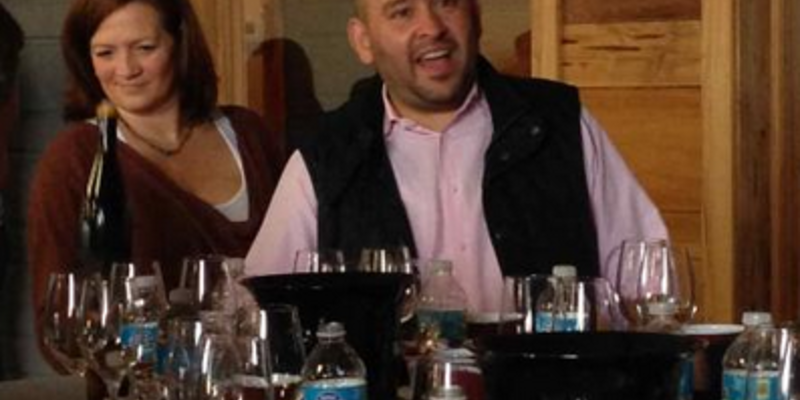
“Trust me, you’d never want to live there.”
Duncan Arnot-Meyers is talking about one of the vineyards where grapes are grown for his award-winning wines. And while he doesn’t live there either, he certainly spends a lot of time there examining the vines, testing the soil, and generally reveling in the steep hillside lot overlooking San Pablo Bay at the end of the Napa Valley. It’s clear that he loves the site—a grin flashes on his face while he’s telling us how uncomfortable it is—and that it is the perfect source for his philosophy of winemaking: simple, spare, and sustainable.

Arnot Meyers was at a tasting I attended for Charleston sommeliers (and a gate-crashing blogger) arranged by Harry Root and his company, Grassroots Wine. Harry and his team supply most of the wine to Charleston’s fine dining scene and gathered three California wine luminaries for a show-and-tell at High Wire Distilling Co. last Thursday: Arnot-Meyers, Anthony Filiberti, and Rajat Parr.
Separated into three groups, the somms remained seated while the winemakers rotated between tables to explain their wines and answer questions. My table began with Arnot Meyers and his rigorous (almost Franciscan) approach to winemaking.

“We spent 10 years looking for right place to plant Pinot,” he says.
A theme soon emerges from the conversation: great wine comes from not-so-great places. Stony, wind-swept, sloped, and generally hostile, the Watson Ranch Vineyard where Arnot Meyers grows Chardonnay seems like a great place for a rockslide and little else. And yet amazing fruit is coaxed out of the site and transformed into a bright, vibrant wine with none of the cloying sweetness found from inland Chard producers.
Duncan Arnot Meyers, Arnot Roberts
If Arnot Meyers is the quintessential tortured artist, then Anthony Filiberti is the stereotypical farmer. Wholly resigned to the whims of Mother Nature, Filiberti offers a portrait of fine winemaking as something the weather only occasionally permits.
“In 2011, we had eight inches of rain before harvest and had to hustle because the rot was setting in. In 2012, more rain. We had to drop about a third of the harvest and hope for the best with the rest. This year was better but too dry…we went five weeks without a drop.”
Lean, weather-beaten, and obviously obsessed with dirt, Filiberti reminds us that much of what makes a wine great occurs before the vinification process. It’s a dispiriting truth for those of use who like to imagine winemaking as a cellar and tasting room process, not a pruning-branches-while-getting-rained-on process.
Anthony Filiberti, Anthill Farms and Knez Winery
www.anthillfarms.com, www.knezwinery.com

But hope springs eternal: enter Rajat “Raj” Parr, a longtime sommelier-turned-winemaker with none of the angst or masochism of Filiberti or Arnot Meyers. Jovial and enthusiastic, he speaks of wines that balance fruit with acidity, personality with structure.
Alas, even Parr would eventually succumb to the theme of hard work and discomfort. When pressed on collaboration and decision-making process among winemakers, he conceded that it wasn’t always smooth.
“I make wines that I want to drink,” he explains. “Not to anyone else’s taste.”
Parr’s commitment to his own palate separates him not only from much of the marketplace but also fellow winemakers. It’s a sacrifice he’s obviously willing – even delighted – to make.
Rajat Parr, Sandhi
Follow him at @sandhiwines

Throughout the tasting, Root meandered between tables refilling glasses and chiming in with questions. As Charleston’s unofficial wine guru and one of our best connections to the new California winemaking scene, he’s obviously excited by the wines and the personalities behind them.
Speaking of the difference between the high-alcohol, fruit-drenched wines that dominate much of the American marketplace and the clean, bright flavors of the wines made by Arnot Meyers, Filiberti and Parr, he offers this analogy. “There are wines that make me want to go home and go to sleep, and then there are wines that make me want to go home and have sex with my wife. These guys make the second one.”
Harry Root, Grassroots Wine
Follow him at @grassrootssc
